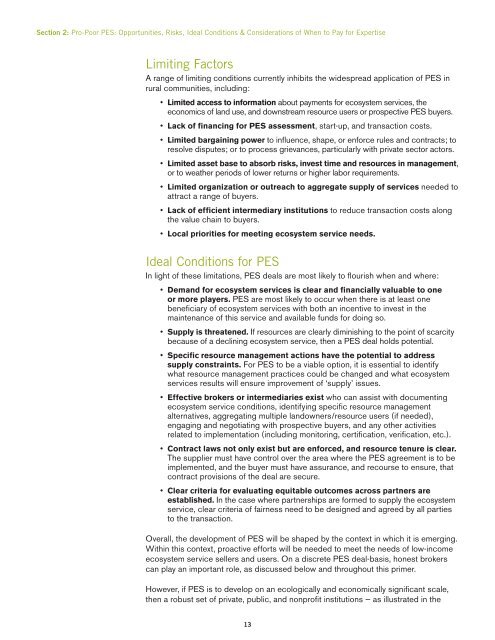Payments for Ecosystem Services: Getting Started. A Primer - UNEP
Payments for Ecosystem Services: Getting Started. A Primer - UNEP
Payments for Ecosystem Services: Getting Started. A Primer - UNEP
Create successful ePaper yourself
Turn your PDF publications into a flip-book with our unique Google optimized e-Paper software.
Section 2: Pro-Poor PES: Opportunities, Risks, Ideal Conditions & Considerations of When to Pay <strong>for</strong> Expertise<br />
Limiting Factors<br />
A range of limiting conditions currently inhibits the widespread application of PES in<br />
rural communities, including:<br />
• Limited access to in<strong>for</strong>mation about payments <strong>for</strong> ecosystem services, the<br />
economics of land use, and downstream resource users or prospective PES buyers.<br />
• Lack of financing <strong>for</strong> PES assessment, start-up, and transaction costs.<br />
• Limited bargaining power to infl uence, shape, or en<strong>for</strong>ce rules and contracts; to<br />
resolve disputes; or to process grievances, particularly with private sector actors.<br />
• Limited asset base to absorb risks, invest time and resources in management,<br />
or to weather periods of lower returns or higher labor requirements.<br />
• Limited organization or outreach to aggregate supply of services needed to<br />
attract a range of buyers.<br />
• Lack of efficient intermediary institutions to reduce transaction costs along<br />
the value chain to buyers.<br />
• Local priorities <strong>for</strong> meeting ecosystem service needs.<br />
Ideal Conditions <strong>for</strong> PES<br />
In light of these limitations, PES deals are most likely to fl ourish when and where:<br />
• Demand <strong>for</strong> ecosystem services is clear and financially valuable to one<br />
or more players. PES are most likely to occur when there is at least one<br />
benefi ciary of ecosystem services with both an incentive to invest in the<br />
maintenance of this service and available funds <strong>for</strong> doing so.<br />
• Supply is threatened. If resources are clearly diminishing to the point of scarcity<br />
because of a declining ecosystem service, then a PES deal holds potential.<br />
• Specific resource management actions have the potential to address<br />
supply constraints. For PES to be a viable option, it is essential to identify<br />
what resource management practices could be changed and what ecosystem<br />
services results will ensure improvement of ‘supply’ issues.<br />
• Effective brokers or intermediaries exist who can assist with documenting<br />
ecosystem service conditions, identifying specifi c resource management<br />
alternatives, aggregating multiple landowners/resource users (if needed),<br />
engaging and negotiating with prospective buyers, and any other activities<br />
related to implementation (including monitoring, certifi cation, verifi cation, etc.).<br />
• Contract laws not only exist but are en<strong>for</strong>ced, and resource tenure is clear.<br />
The supplier must have control over the area where the PES agreement is to be<br />
implemented, and the buyer must have assurance, and recourse to ensure, that<br />
contract provisions of the deal are secure.<br />
• Clear criteria <strong>for</strong> evaluating equitable outcomes across partners are<br />
established. In the case where partnerships are <strong>for</strong>med to supply the ecosystem<br />
service, clear criteria of fairness need to be designed and agreed by all parties<br />
to the transaction.<br />
Overall, the development of PES will be shaped by the context in which it is emerging.<br />
Within this context, proactive ef<strong>for</strong>ts will be needed to meet the needs of low-income<br />
ecosystem service sellers and users. On a discrete PES deal-basis, honest brokers<br />
can play an important role, as discussed below and throughout this primer.<br />
However, if PES is to develop on an ecologically and economically signifi cant scale,<br />
then a robust set of private, public, and nonprofi t institutions — as illustrated in the<br />
13
















